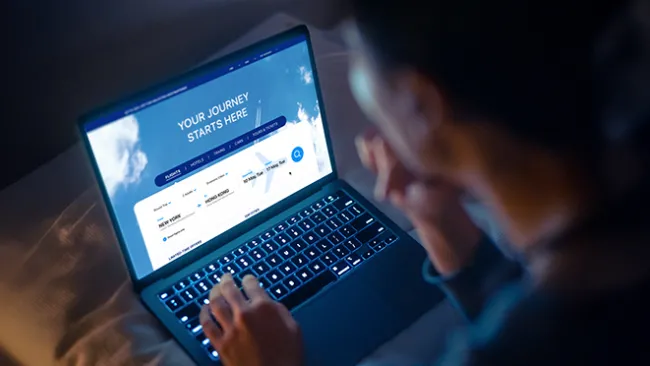When discussing customer strategy, Robert Deluce prefers to focus more on service and less on numbers. Deluce, president and CEO of Toronto-based Porter Airlines, emphasizes the importance of his young company's underlying service philosophy and employee conduct, which translate Porter's "Flying Refined" core value into practice.
But there are several vital statistics to consider: Porter Airlines, which flies short-haul routes (flights of less than three hours) in eastern Canada and select U.S. cities, is one of only two North American airlines to receive an impressive four-star rating in Skytrax's Airline Star Ranking. New York–based JetBlue is the continent's only other four-star airline, according to Skytrax; all of the other major North American carriers, including Air Canada, American, Southwest, and United, currently have three-star ratings. One reason for this recognition stems from another notable measure: 34 inches. That's how much legroom, as defined by airlines' metric of seat pitch, passengers on Porter Airlines enjoy—two to three more inches of legroom than what is available on the similar-sized airplanes of other short-haul airlines.
Legroom is hardly the only facet of customer experience that Porter Airlines passengers notice and rave about on SKYTRAX discussion boards. Some customers cite the airline's overall approach, e.g., "It takes you back to the days when airlines actually cared for the customers and they were not just a seat number." And some comment on other differentiators: Porter flight attendants' elegant uniforms topped with retro pillbox hats; access for all passengers to well-appointed airline lounges; and complimentary in-flight snacks and beverages (including wine and beer).
Deluce recently touched down to discuss that evangelist-inducing customer strategy.
Customer Strategist: Porter Airlines celebrated its fourth anniversary last October. How did you conceive the company and begin charting a strategy before that inaugural flight in 2006?
Robert Deluce: The Porter experience was certainly considered in great detail before we actually ever started flying. Our "Flying Refined" tagline emphasizes the fact that we strive to restore a certain level of dignity to air travel for all of our passengers.
When we were back at the drawing board and looking at what we wanted to create, we recognized that there was a serious gap in the market, especially for short-haul travel. You could pay for first- or business-class treatment on other airlines but you were not getting the value you were paying for, especially not on one- and two-hour flights. It had almost become the norm in the industry to regularly take away amenities and then ask the passenger to pay more for them—if you made the amenities available at all.
Porter was built and designed to provide a premium travel experience that does not require passengers to take out their wallet. A glass of wine, access to the lounge, extra legroom, and more are included [in the ticket price] and available to every passenger. I think we have filled the short-haul premium travel market quite nicely.
CS: Can you describe your approach to customer strategy in one sentence?
RD: We happen to be an airline and we use aircraft to deliver people safely from point A to point B, but we are very much in the customer service business.
CS: How do you execute that strategy in an industry with so many moving parts, including some issues that pose direct challenges to the customer experience?
RD: We are in a business with numerous variables, including weather, machinery, airport conditions, and much more. Sometimes, some of these things are out of our control. When bad weather, airport operation issues, or any other number of circumstances cause flight delays or other problems, the important thing to the customer is not so much that there has been an issue, but rather how you recognize the impact to the passenger and how you recover from the issue.
That response is usually remembered more vividly than the original problem itself. It's always good to be mindful of the fact that sometimes things do happen and it's how you take care of the customer when these things happen that is a crucial part of the puzzle.
CS: From an organizational culture perspective, what are the most important building blocks of a customer-centric company?
RD: This involves developing a corporate culture that supports customer service. It is easier to develop that culture right from the get-go than to try to take somebody else's concepts and remold into one that fits your organization.
Today, we have roughly 1,200 team members. In the early stages when we were going through the preparation necessary to get us to a point where we could have passengers flying routes, the first 20 people we brought on board were handpicked for their customer service experience and their entrepreneurial spirit.
CS: Please share some details about the three Porter airport lounges.
RD: The lounge is one of the key aspects of the overall Porter experience. It emphasizes our brand. It is available to everyone. They are spacious, comfortable, and offer amenities such as specialty coffee, soft drinks, and snacks.
Our lounges are designed specifically with passengers in mind, and it's very much a business-class experience. The lounges help passengers feel comfortable, and they are almost an extension of our customers' homes, if you will. Our lounge, in-flight experience, shuttle bus service, check-in process, designer [flight attendant] uniforms, premium in-flight service, and even the aircraft itself with its spacious layout, extra legroom, and leather seats—all of this is geared toward enhancing passenger comfort and creating a warm and refined experience. It all fits nicely together in terms of creating an overall travel experience that is different from what you typically get on another airline.
CS: How do you know your approach is working?
RD: We rely heavily on customer feedback, and we get that in various forms. We receive a large amount of direct communications from passengers and we participate in business travel surveys. Both of those forms are always quite telling.
Another strong [success] indicator is that so many airports are coming forward and expressing their desire to have Porter service to their community. That's quite a bit different than what existed when we first started providing service; then, not many communities had even heard of us. We have no shortage of choices when it comes to growth opportunities. Our customer service reputation is certainly one factor that has resulted in this long list of suitors in the form of other airports. It also helps recruiting efforts. People want to be associated with a company that has a positive reputation among customers and treats its employees well.
CS: From a leadership perspective, how do you plan to maintain your emphasis on service and "Flying Refined" as the company grows?
RD: When you are building a company that is centered on customer service, the CEO can't be the only problem solver. That simply doesn't work when you have millions of customers.
It's really a matter of empowering individuals to make critical decisions and putting them in a position where they can satisfy customers in a proactive way—not days after the event, but on the spot as events are occurring. That's what we strive to do.
We accomplish that in a variety of ways. It involves training and it means ensuring that staff know that they have a certain amount of leeway and the support from management to always err on the side of the customer. Team members ultimately know that if their intentions are motivated by doing what's best for the customers—if that's guiding their behavior—that will be helpful because satisfied customers translate to long-term business success.















